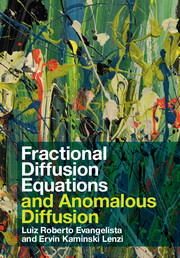Refine search
Actions for selected content:
6993 results in Mathematical modeling and methods
6 - Fractional Nonlinear Diffusion Equations
-
- Book:
- Fractional Diffusion Equations and Anomalous Diffusion
- Published online:
- 17 January 2018
- Print publication:
- 25 January 2018, pp 169-199
-
- Chapter
- Export citation

Fractional Diffusion Equations and Anomalous Diffusion
-
- Published online:
- 17 January 2018
- Print publication:
- 25 January 2018
ANZ VOLUME 59 ISSUE 2 COVER AND BACK MATTER
-
- Journal:
- The ANZIAM Journal / Volume 59 / Issue 2 / October 2017
- Published online by Cambridge University Press:
- 04 December 2017, pp. b1-b9
-
- Article
-
- You have access
- Export citation
ANZ VOLUME 59 ISSUE 2 COVER AND FRONT MATTER
-
- Journal:
- The ANZIAM Journal / Volume 59 / Issue 2 / October 2017
- Published online by Cambridge University Press:
- 04 December 2017, pp. f1-f2
-
- Article
-
- You have access
- Export citation
BI-LEVEL PROGRAMMING APPROACH TO OPTIMAL STRATEGY FOR VENDOR-MANAGED INVENTORY PROBLEMS UNDER RANDOM DEMAND
- Part of
-
- Journal:
- The ANZIAM Journal / Volume 59 / Issue 2 / October 2017
- Published online by Cambridge University Press:
- 20 November 2017, pp. 247-270
-
- Article
-
- You have access
- Export citation
A NOTE ON COMPUTING THE INTERSECTION OF SPHERES IN
 $\mathbb{R}^{n}$
$\mathbb{R}^{n}$
- Part of
-
- Journal:
- The ANZIAM Journal / Volume 59 / Issue 2 / October 2017
- Published online by Cambridge University Press:
- 02 November 2017, pp. 271-279
-
- Article
-
- You have access
- Export citation
THE DEMON DRINK
- Part of
-
- Journal:
- The ANZIAM Journal / Volume 59 / Issue 2 / October 2017
- Published online by Cambridge University Press:
- 02 November 2017, pp. 135-154
-
- Article
-
- You have access
- Export citation
PREDATOR–PREY MODEL WITH AGE STRUCTURE
- Part of
-
- Journal:
- The ANZIAM Journal / Volume 59 / Issue 2 / October 2017
- Published online by Cambridge University Press:
- 02 November 2017, pp. 155-166
-
- Article
-
- You have access
- Open access
- Export citation
SEMI-ANALYTICAL SOLUTIONS FOR THE BRUSSELATOR REACTION–DIFFUSION MODEL
- Part of
-
- Journal:
- The ANZIAM Journal / Volume 59 / Issue 2 / October 2017
- Published online by Cambridge University Press:
- 23 October 2017, pp. 167-182
-
- Article
-
- You have access
- Export citation
A DIRECT SEARCH QUASI-NEWTON METHOD FOR NONSMOOTH UNCONSTRAINED OPTIMIZATION
-
- Journal:
- The ANZIAM Journal / Volume 59 / Issue 2 / October 2017
- Published online by Cambridge University Press:
- 23 October 2017, pp. 215-231
-
- Article
-
- You have access
- Export citation
PRICING EUROPEAN OPTIONS ON REGIME-SWITCHING ASSETS: A COMPARATIVE STUDY OF MONTE CARLO AND FINITE-DIFFERENCE APPROACHES
- Part of
-
- Journal:
- The ANZIAM Journal / Volume 59 / Issue 2 / October 2017
- Published online by Cambridge University Press:
- 23 October 2017, pp. 183-199
-
- Article
-
- You have access
- Export citation
MULTIPLICATIVELY CLOSED MARKOV MODELS MUST FORM LIE ALGEBRAS
- Part of
-
- Journal:
- The ANZIAM Journal / Volume 59 / Issue 2 / October 2017
- Published online by Cambridge University Press:
- 23 October 2017, pp. 240-246
-
- Article
-
- You have access
- Export citation
A NEW MINIMIZATION PRINCIPLE FOR THE POISSON EQUATION LEADING TO A FLEXIBLE FINITE ELEMENT APPROACH
- Part of
-
- Journal:
- The ANZIAM Journal / Volume 59 / Issue 2 / October 2017
- Published online by Cambridge University Press:
- 03 October 2017, pp. 232-239
-
- Article
-
- You have access
- Export citation
BOUND STATES IN WEAKLY DEFORMED WAVEGUIDES: NUMERICAL VERSUS ANALYTICAL RESULTS
- Part of
-
- Journal:
- The ANZIAM Journal / Volume 59 / Issue 2 / October 2017
- Published online by Cambridge University Press:
- 03 October 2017, pp. 200-214
-
- Article
-
- You have access
- Export citation
ANZ VOLUME 59 ISSUE 1 COVER AND BACK MATTER
-
- Journal:
- The ANZIAM Journal / Volume 59 / Issue 1 / July 2017
- Published online by Cambridge University Press:
- 25 August 2017, pp. b1-b5
-
- Article
-
- You have access
- Export citation
ANZ VOLUME 59 ISSUE 1 COVER AND FRONT MATTER
-
- Journal:
- The ANZIAM Journal / Volume 59 / Issue 1 / July 2017
- Published online by Cambridge University Press:
- 25 August 2017, pp. f1-f2
-
- Article
-
- You have access
- Export citation
FIFTH-ORDER EVOLUTION EQUATION OF GRAVITY–CAPILLARY WAVES
- Part of
-
- Journal:
- The ANZIAM Journal / Volume 59 / Issue 1 / July 2017
- Published online by Cambridge University Press:
- 09 August 2017, pp. 103-114
-
- Article
-
- You have access
- Export citation
TRUCK SAFETY BARRIERS FOR MINING SITES
- Part of
-
- Journal:
- The ANZIAM Journal / Volume 59 / Issue 1 / July 2017
- Published online by Cambridge University Press:
- 31 July 2017, pp. 35-50
-
- Article
-
- You have access
- Export citation
AN ANALYTICAL APPROACH FOR VARIANCE SWAPS WITH AN ORNSTEIN–UHLENBECK PROCESS
- Part of
-
- Journal:
- The ANZIAM Journal / Volume 59 / Issue 1 / July 2017
- Published online by Cambridge University Press:
- 19 July 2017, pp. 83-102
-
- Article
-
- You have access
- Export citation
ON MODELLING THE TRANSITION TO TURBULENCE IN PIPE FLOW
- Part of
-
- Journal:
- The ANZIAM Journal / Volume 59 / Issue 1 / July 2017
- Published online by Cambridge University Press:
- 11 July 2017, pp. 1-34
-
- Article
-
- You have access
- Export citation




